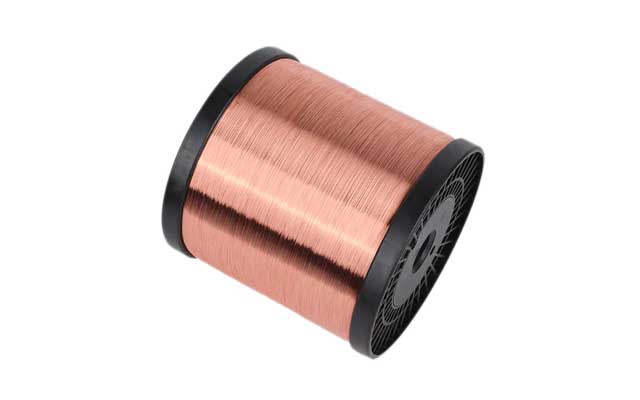Symbol CCAPurity /Size 0.08-8.25 mmType Composite wireElongation /Tensile /
Copper-clad Aluminum Wire
Copper clad aluminum wire is a composite wire with aluminum as the core material and an outer layer of copper coating. It combines the lightweight of aluminum with the conductivity of copper and is a lightweight conductive material in fields such as high-frequency communication and new energy vehicles.
Core Features
Lightweight: Density of 3.5~4.5 g/cm ³ (40%~50% of pure copper), significantly reducing cable weight.
Conductivity: Copper layer conductivity ≥ 90% IACS (close to pure copper performance under high-frequency skin effect).
Cost advantage: Aluminum core replaces pure copper, reducing material costs by 30% to 50%.
Corrosion resistance: The copper layer protects the aluminum core and has a salt spray resistance life of ≥ 10 years (in industrial environments).
Manufacturing Process
The production process of tinned copper-clad steel wire includes steel core treatment → copper coating → tin plating → post-treatment. The core steps of different processes are as follows:
Electroplating Method (mainstream process)Pre treatment of steel core:
Acid washing (10% H2SO4 to remove oxide skin) → electrolytic degreasing (alkaline solution) → activation (fluoroboric acid).
Electroplated copper:
Plating solution: 200g/L copper sulfate+50g/L sulfuric acid, current density of 3 A/dm2, copper layer thickness of 10-50 μm.
Electroplated tin plating:
Plating solution: 100 g/L tin methylsulfonate+additives (brightener, stabilizer), current density of 1.5 A/dm2, tin layer thickness of 5-20 μm.
Post processing:
Passivation (chromate solution) → wax lubrication → winding.
Hot Dip Plating Method (thick coating)Copper coating:
Immerse the steel core in molten copper solution (1150 °C) → cool and shape → pull to the target diameter.
Hot dip tin:
Copper clad steel wire immersed in molten tin solution (260 °C) → air knife controlled tin layer thickness → water cooling.
Surface treatment:
Polishing (surface roughness Ra ≤ 0.8 μm) → Anti oxidation coating (such as silicone oil).
Wrap Welding Method (high bonding strength)Copper tape wrapping:
Copper strip (thickness 0.2mm) wraps around the steel core → high-frequency welding (900 °C) forms metallurgical bonding.
Tin plating:
Electroplating or hot-dip tin plating, with a coating thickness of 10-50 μm.
testing:
The X-ray thickness gauge detects the uniformity of the coating (with an error of ± 2 μm).
Copper-clad Aluminum Wire List
| Diameter |
Tolerance |
Elongation |
Tensile Strength |
| 0.080 -0.344 mm |
±0.003 mm |
≥1% |
≥205 MPa |
| 0.345-0.500 mm |
±0.004 mm |
≥1% |
≥207 MPa |
| 0.501-8.25 mm |
±1% |
≥1% |
≥110 MPa |
Copper-clad Aluminum Wire Application
Copper clad aluminum wire has significant advantages such as lightweight, low cost, high-frequency conductivity close to pure copper, and better corrosion resistance than pure aluminum. It is widely used in the following scenarios:
Communication and Electronics5G base station RF cable: single core wire with a diameter of 0.5mm, high-frequency loss ≤ 0.2 dB/m (28 GHz).
Coaxial cable shielding layer: multi-core twisted wire (cross-sectional area 10 mm2), coverage rate ≥ 95%.
Automotive IndustryHigh voltage wiring harness: cross-sectional area of 25-50 mm2, current carrying capacity of 100-200 mA, weight reduced by 40%.
Battery connector: Copper layer thickness of 30 μm, contact resistance ≤ 0.15m Ω.
New Energy and ElectricityPhotovoltaic connection line: resistant to UV aging, with a lifespan of ≥ 25 years (IEC 62930 standard).
Transformer winding: Flat wire copper-clad aluminum wire (cross-sectional area 5 × 2mm), with a 20% increase in slot filling rate.
Consumer ElectronicsType-C data cable: Diameter 0.3 mm, bending life ≥ 10000 times.
Wireless earphone coil: Leeds wire structure (50 strands x 0.05 mm), reducing eddy current losses.
EADSSatellite cable: Lightweight stranded wire (density 4g/cm3), replacing pure copper to reduce weight by 50%.
Drone cable: cross-sectional area of 0.5 mm2, tensile strength ≥ 180 MPa.


